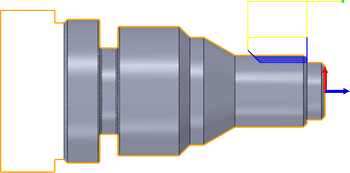
|
Access: |
Ribbon:
CAM tab
 Turning panel
Turning panel
 Thread
Thread

|
The Thread strategy is used for turning both cylindrical and conical threads. The CNC control must have built-in support for synchronizing the spindle and feed.
 Tool tab settings
Tool tab settings
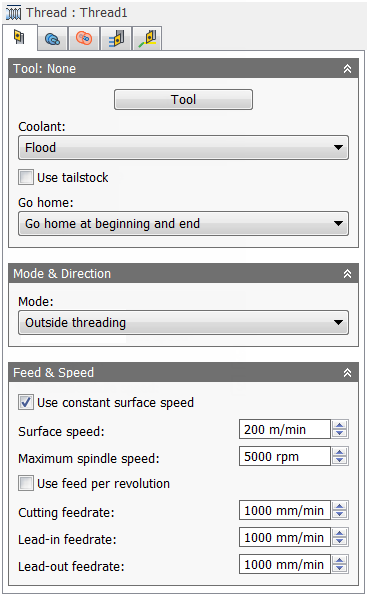
Coolant:
The type of coolant used with the tool.
Use tailstock
A tailstock is used to apply support to the longitudinal rotary axis of the workpiece being machined. This is particularly useful when the workpiece is relatively long and slender. Failing to use a tailstock can cause the workpiece to bend excessively while being cut and cause "chatter".
For this option to take effect, your machine needs a programmable tailstock and your post processor has to be configured to write the code your machine needs.
Once configured, you would typically see M21 (tailstock forward) at the beginning of the operation and M22 (tailstock backward) at the end with this option enabled.
Go home:
The Home position is a known Z value relative to the WCS and is defined within the Work Coordinate System (WCS) section on the Setup tab of the Setup strategy dialog.
You can force the tool to move to the Home position prior to starting the operation, or once the operation has finished. The tool will always pull out of the stock in the X axis until it reaches the Clearance height, then move to the Home position in the Z.
-
Don't go home
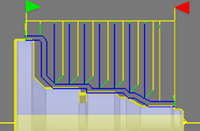
Don't Go Home
-
Go home at beginning
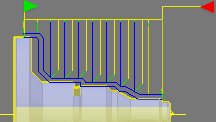
Go Home At Beginning
-
Go home at end
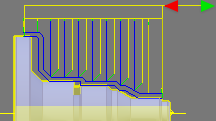
Go Home At End
-
Go home at beginning and end
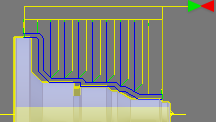
Go Home At Beginning And End
Mode:
Depending on the turning strategy, this setting determines whether the tool machines axially or radially as well as the approach/retract direction.
- Outside threading - The tool approaches from/retracts to the outside of the stock and machines axially.
- Inside threading - The tool approaches from/retracts to the centerline and machines radially.
Use constant surface speed
Enable to automatically adjust the spindle speed to maintain a constant surface speed between the tool and the workpiece as the cutting diameter changes . Constant Surface Speed (CSS) is specified using G96 on most machines.
Spindle speed:
The rotational speed of the spindle.
Surface speed:
The spindle speed expressed as the speed of the tool on the surface.
Maximum spindle speed:
Specifies the maximum allowed spindle speed when using Constant Surface Speed (CSS).
Use feed per revolution
Enable to automatically adjust the feedrate based on the RPM of the spindle to maintain a constant chip speed.
Cutting feedrate:
Feed used in cutting moves.
Lead-in feedrate:
Feed used when leading in to a cutting move.
Lead-out feedrate:
Feed used when leading out from a cutting move.
 Geometry tab settings
Geometry tab settings
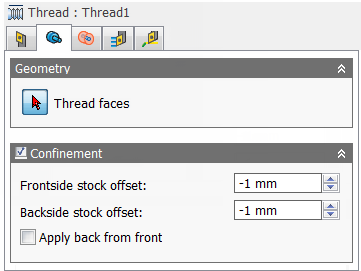
Thread faces
Selection button for faces to be threaded.
Confinement
Toolpaths can be contained within a specific region using the Confinement button to select confinement boundaries. Confinement regions can be defined with a combination of edges, surfaces, or sketch points.
Frontside stock offset:
Specifies the distance to machine beyond the frontside of the model.
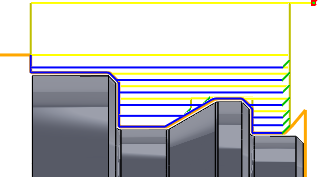
Negative Frontside Offset
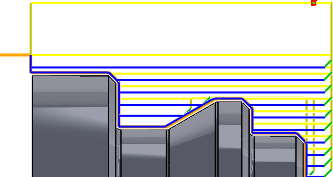
Positive Frontside Offset
Backside stock offset:
Specifies the distance to machine beyond the backside of the model.

Negative Backside Offset

Positive Backside Offset
Apply back from front
Makes the stock backside offset apply from the front side.
 Radii tab settings
Radii tab settings
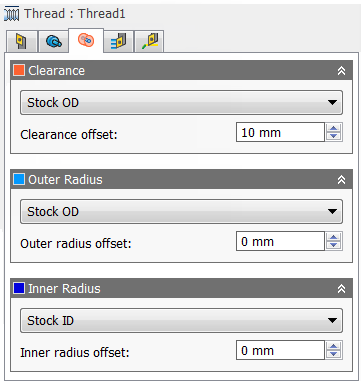
Clearance
Set this height to control the radius where the tool enters and exits the toolpath. The tool approaches and retracts from inside the stock along the Z axis (spindle axis) at this radial clearance offset. The value displayed on the orange tab represents its current radius relative to the setup axis.
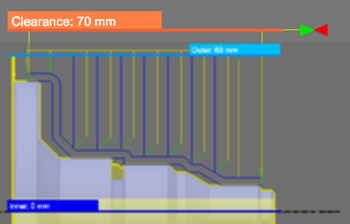
Outer Clearance Radius
- Stock OD- Sets the clearance radius to match the radial extremities of the stock defined in the setup.
- Model OD - Sets the clearance radius to match the outer radial extremities of the model as defined in the setup.
- Outer radius - Choosing this option allows you to offset the clearance radius from the Outer radius. However, the clearance radius must be larger than the Outer radius, so a positive value must be entered in the Clearance offset field.
- Inner radius - Using this option in combination with the Clearance offset value allows you to drive the Clearance radius from the innermost location where tool paths are generated. This is a useful method for containing toolpath depth in certain scenarios. Make sure the clearance radius results in the tool clearing all remaining stock. This can be verified by running stock simulation.
- Model ID - Using this option in combination with the Clearance offset value allows to you to drive the Clearance radius from the smallest diameter of the defined stock. Make sure the clearance radius results in the tool clearing all remaining stock. This can be verified by running stock simulation.
- Stock ID - Using this option in combination with the Clearance offset value allows to you to drive the Clearance radius from the smallest diameter of the defined stock. Make sure the clearance radius results in the tool clearing all remaining stock. This can be verified by running stock simulation.
- Selection - Select any face, vertex, or point on the model to define the Clearance radius.
- Radius - This option allows you to enter a radius value in the Clearance offset field.
- Diameter - This option allows you to enter a diameter value in the Clearance offset field.
Clearance offset:
Specifies the clearance offset value.
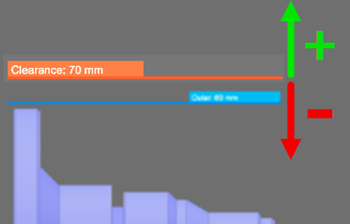
Outer Clearance Offset
Outer Radius
Defines the radial confinement by limiting the outer radial range of the toolpath. You can choose from the following:
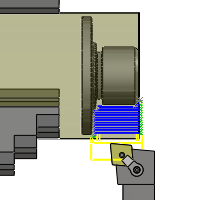
Outer Radius
- Stock OD
- Model OD
- Inner limit
- Model ID
- Stock ID
- Selection
- Radius
- Diameter
Outer radius offset:
Specifies the outer radius offset value.
Inner Radius
Defines the radial confinement by limiting the inner radial range of the toolpath. You can choose from the following:

Inner Radius
- Stock OD
- Model OD
- Outer limit
- Model ID
- Stock ID
- Selection
- Radius
- Diameter
Inner radius offset:
Specifies the inner radius offset value.
 Passes tab settings
Passes tab settings
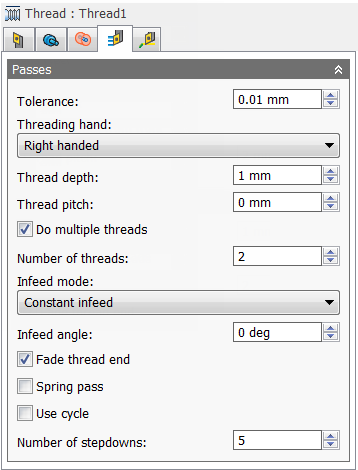
Tolerance:
The machining tolerance is the sum of the tolerances used for toolpath generation and geometry triangulation. Any additional filtering tolerances must be added to this tolerance to get the total tolerance.
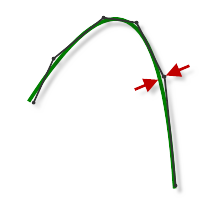
Loose Tolerance .100
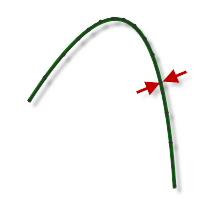
Tight Tolerance .001
CNC machine contouring motion is controlled using line G1 and arc G2 G3 commands. To accommodate this, CAM approximates spline and surface toolpaths by linearizing them; creating many short line segments to approximate the desired shape. How accurately the toolpath matches the desired shape depends largely on the number of lines used. More lines result in a toolpath that more closely approximates the nominal shape of the spline or surface.
Data Starving
It is tempting to always use very tight tolerances, but there are trade-offs including longer toolpath calculation times, large G-code files, and very short line moves. The first two are not much of a problem because Inventor HSM calculates very quickly and most modern controls have at least 1MB of RAM. However, short line moves, coupled with high feedrates, may result in a phenomenon known as data starving.
Data starving occurs when the control becomes so overwhelmed with data that it cannot keep up. CNC controls can only process a finite number of lines of code (blocks) per second. That can be as few as 40 blocks/second on older machines and 1,000 blocks/second or more on a newer machine like the Haas Automation control. Short line moves and high feedrates can force the processing rate beyond what the control can handle. When that happens, the machine must pause after each move and wait for the next servo command from the control.
Threading hand:
- Right handed
- Left handed
Thread depth:
Specifies the thread depth.
Thread pitch:
Specifies the thread pitch.
Do multiple threads
Enable to activate the number of threads.
Number of threads:
Specifies the number of threads.
Infeed mode:
The infeed is the depth of cut per pass and is critical in threading. Each successive pass engages a larger portion of the cutting edge of the insert. There are two infeed mode options.
- Constant infeed - With this option, the cutting force and metal removal rate can increase dramatically from one pass to the next. Example: When producing a 60 degree thread form using a constant 0.010 inch infeed per pass, the second pass removes three times the amount of metal as the first pass. The amount of metal removed continues to grow exponentially with each subsequent pass.
- Reduced infeed - This option maintains more realistic cutting forces and reduces the depth of cut with each pass. Because it avoids the increased metal removal rate of constant infeed, it is the recommended setting.
Infeed angle:
Specifies the infeed angle.
Fade thread end
Enable to fade out the thread at the end.
Spring pass
Enable to perform the final finishing pass twice to remove stock left due to tool deflection.
Use cycle
Enable to request output as canned cycle.
Number of stepdowns:
Specifies the desired number of stepdowns.
 Linking tab settings
Linking tab settings
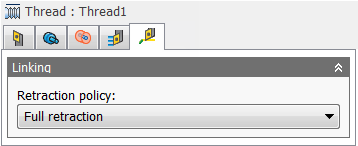
Retraction policy:
Controls how the tool should retract to the clearance diameter after every cutting pass. or just retract a short distance away from the job. The distance is determined by the Safe Distance value.
-
Full retraction - completely retracts the tool to the
Retract Height at the end of the pass before moving above the start of the next pass.
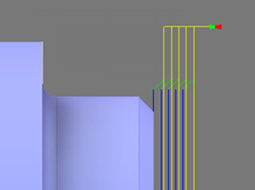
Full retraction
-
Minimum retraction - moves straight up to the lowest height where the tool clears the workpiece, plus any specified safe distance.
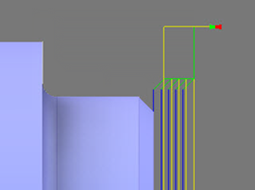
Minimum retraction